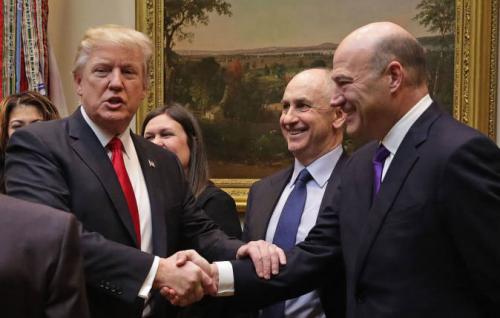Less than a week after Bridgewater’s Ray Dalio flip-flopped in his support of Donald Trump, going from vocally praising the billionaire’s vision for the US, to becoming “increasingly concerned about the emerging policies of the Trump administration” because “there is significant risk that his populist policies could hurt the world economy (and worse),” it was Goldman’s turn to dramatically sour on Trump’s economic policies, and as the bank’s chief economist, who previously just like Dalio was ecstatic about the economic growth prospects under President Trump, warned in a Friday night note that “one month into the year, the balance of risks is somewhat less positive in our view.”
As the Goldman team writes, following the election, there was a burst in euphoria and “the positive shift in sentiment among investors, business, and consumers suggested that the probability of tax cuts and easier regulation was seen to be higher than the probability of meaningful restrictions to trade and immigration”, however three months later “the risks are less positively tilted than they appeared shortly after the election.”
Hatzius gave three reasons for why his outlook has soured so much:
In short, everything we said was bound to happen in late November has now, again, become mainstream. So with that caveat in mind, what does Goldman believe will happen next: for now, much of the same as before, however in what is perhaps the most notable shift, Goldman – whose former president Gary Cohn now is in charge of Trump’s economic policies – now sees only a 20% chance the border adjustment tax will be included in tax reform. If so, sell the dollar (something Goldman’s FX team will most certainly not be happy about).
We continue to expect a fiscal expansion of around 1% of GDP, largely through tax cuts starting in 2018. We believe Congress will reduce the corporate tax rate to 25%, but do not expect “border adjustment” to be included in tax reform. We also expect an increase in the effective tariff rate on imports and a reduction in immigration flows.
If Goldman is right, expect little if any Trump policies to be implemented until mid to late 2081, and not only the various near-all time high “soft” economic indicators like consumer and business confidence to roll over steeply in the coming weeks as optimism fades, but more importantly, hard data to plunge, dragging the USD, yields and stocks along with it.

Donald Trump and former Goldman President, current Chief economic advisor, Gary Cohn
For those curious, Goldman’s full revised Q&A on Trump’s policy outook is below (highlights our).
Q: What are the main issues at play?
We look at the agenda in two ways. First, it is useful to separate the issues that, while important, are largely political or microeconomic priorities from the more fundamental economic policy issues that are likely to have greater macroeconomic and financial market consequences. In the first group, we would count issues like the repeal of the Affordable Care Act (ACA, or “Obamacare”) and the upcoming debate over the President’s nominee for the Supreme Court, Neil Gorsuch, as well as a number of the targeted regulatory changes that might affect specific industries—Congress is poised to overturn certain targeted environmental regulations, for example. The more time Congress and the Administration spend on these issues at the outset, the longer it will likely take to address the core economic issues that market participants are largely focused on.
Second, among those issues that have meaningful macroeconomic consequences, there are risks in both directions. Tax reform, which we expect to result in a net reduction in tax liabilities, is likely to boost growth in 2018 and 2019. Infrastructure funding could provide a slight additional boost, though its fate is less clear. However, immigration restrictions could lead to an overly tight labor market and a slowing in final demand, and trade restrictions could pose risks to corporate profits and ultimately to growth if trading partners retaliate.
* * *
Q: How have those risks shifted since the election?
The risks are less positively tilted than they appeared shortly after the election. Sentiment among investors, business, and consumers improved in November and December and risk assets performed well (Exhibit 1). While an improvement in economic data may be behind some of this, our impression is that the market perceives a higher probability of meaningful tax reduction and regulatory reform, while assigning a lower probability to meaningful trade and immigration restrictions.
Exhibit 1: A post-election boost to sentiment

Source: University of Michigan. Conference Board. NFIB.
Our view has been that the risks are more balanced than market participants might have expected, and recent developments reinforce this view, we believe. First, the difficulty that the Republican majority has encountered in its effort to “repeal and replace” Obamacare does not bode well for quick enactment of tax reform, which would provide most of the fiscal boost that we expect, raising the possibility that tax legislation might not pass until late 2017 or possibly even early 2018, and that it is likely to be less ambitious than the plans put forth by House Republicans and President Trump during the campaign.
Second, while bipartisan cooperation looked possible on some issues following the election, the political environment appears to be as polarized as ever, suggesting that many issues that require bipartisan support are likely to face substantial obstacles. In our view this suggests a low probability of a major infrastructure program that involves new spending in addition to tax incentives, and could pose obstacles to legislation making incremental changes to financial, health, and/or energy regulation, for example. While we have not expected a sweeping overhaul of regulation in any of these areas to become law, recent developments lower the probability somewhat that even incremental changes could pass in the Senate.
Third, some of the recent administrative actions by the Trump Administration serve as a reminder that the president is likely to follow through on campaign promises on trade and immigration, some of which could be disruptive for financial markets and the real economy.
* * *
Q: After such an eventful few weeks, when will the outlook become more certain?
It would be a mistake to simply extrapolate recent political and policy developments, whether more market-friendly moves like the recent announcements on regulatory reform, or actions that have been associated with a negative market reaction, like the executive actions on immigration. That said, we expect policy uncertainty to persist for a while, with a continued mix of news that financial markets interpret positively and negatively. Exhibit 2 shows the range and average of the economic policy uncertainty index at the start of the last three new administrations, indexed to the Election Day level, compared with the current reading. In each of these periods, a new president entered office with his party holding the majority in the House and Senate, as President Trump has this year. We note that the limited historical evidence provides little reason to expect uncertainty to decline significantly over the next few months; in fact, on average it has tended to be more elevated in the spring of the inaugural year than in January. This is in line with our expectation of the next few months, which we expect to produce significant policy developments, particularly regarding fiscal policy, trade, and regulation.














Leave A Comment